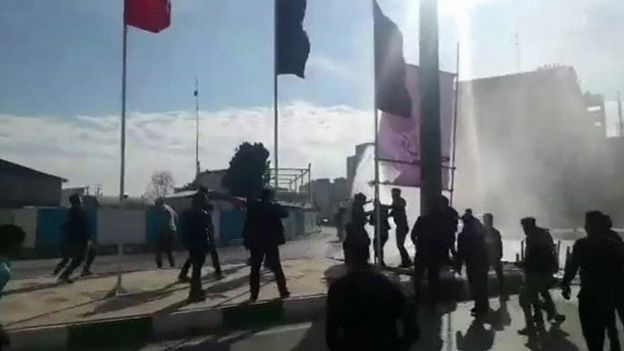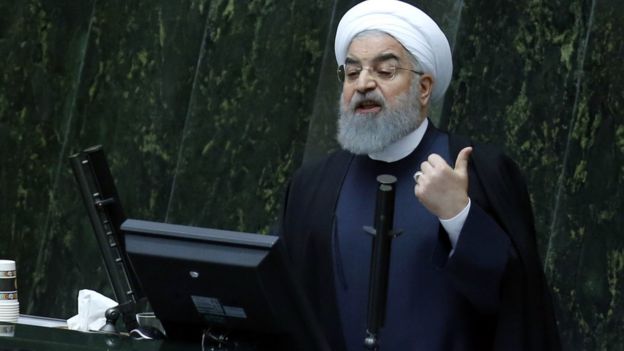The US says "the world is watching"
how Iranian authorities respond to anti-government protests that have
broken out in several cities.
A White House statement said
Iranians were fed up with "the regime's corruption and its squandering
of the nation's wealth to fund terrorism". The US State Department condemned the arrests of dozens of protesters.
Thousands of people are said to have joined demonstrations in the cities of Kermanshah, Rasht, Isfahan and Qom.
The protests spread to the capital, Tehran, on Friday and social media footage showed a heavy police presence there.
It is the biggest display of public dissent since huge pro-reform rallies in 2009.
"The Iranian government should respect their people's rights, including their right to express themselves. The world is watching," White House spokeswoman Sarah Huckabee Sanders said on Twitter.
The US State Department urged all nations "to publicly support the Iranian people and their demands for basic rights and an end to corruption".
What is Iran saying about the protests?
First Vice-President Eshaq Jahangiri has suggested that government opponents are behind the protests, according to comments reported by state broadcaster IRIB. He said: "Some incidents in the country these
days are on the pretext of economic problems, but it seems there is
something else behind them. They think by doing this they harm the
government, but it will be others who ride the wave."
He said: "Some incidents in the country these
days are on the pretext of economic problems, but it seems there is
something else behind them. They think by doing this they harm the
government, but it will be others who ride the wave."
Earlier, Fars news agency reported that protesters in Kermanshah had destroyed some public property and were dispersed.
The governor-general of Tehran said that any such gatherings would be firmly dealt with by the police, who are out in force on the main roads.
Officials in Mashhad said the protest was organised by "counter-revolutionary elements", and video online showed police using water cannon.
Meanwhile state TV said rallies were due to take place on Saturday to commemorate 2009 demonstrations held in support of the then conservative government of Mahmud Ahmedinejad.
Those demonstrations were in response to protests by reformists over a disputed election which returned Mr Ahmedinejad to power.
How did the demonstrations begin?
The current protests started in the north-eastern city of Mashhad - the country's second most-populous - on Thursday.People there took to the streets to express anger at the government over high prices, and vented their fury against President Hassan Rouhani. Fifty-two people were arrested for chanting "harsh slogans".
The protests spread to other cities in the north-east, and some developed into broader demonstrations against the authorities, calling for the release of political prisoners and an end to police beatings.

On Friday, despite warnings from authorities, the demonstrations spread further to some of the biggest cities in the country.
They represent the most serious and widespread expression of public discontent in Iran since 2009, correspondents say.
What is behind the unrest?
The protests were initially against economic conditions and corruption but appear to have turned political.Slogans have been chanted against not just Mr Rouhani but Supreme Leader Ayatollah Ali Khamenei, and clerical rule in general.
Demonstrators were reportedly heard yelling slogans like "The people are begging, the clerics act like God". Protests have even been held in Qom, a holy city home to powerful clerics.
There is also anger at Iran's interventions abroad. In Mashhad, some chanted "not Gaza, not Lebanon, my life for Iran", a reference to what protesters say is the administration's focus on foreign rather than domestic issues.
- Iran 'building permanent military base' in Syria
- Yemen crisis: Who is fighting whom?
- Why Saudi Arabia and Iran are bitter rivals
It is also accused of providing arms to Houthi rebels fighting a Saudi-led coalition in Yemen, which it denies, and is an ally of Lebanon's powerful Shia movement Hezbollah.
Are the protests growing?
There have been calls on social media for protests up and down the country, despite warnings from the government against illegal gatherings.Demonstrations of varying sizes are reported to have occurred in at least seven cities.
Overall, the numbers said to be taking part range from a less than 100 in some places to thousands in others - but demonstrations do not appear to be taking place on a massive scale.






No comments:
Post a Comment
We value your response, Give your comments here